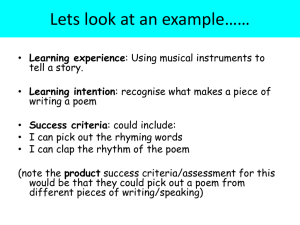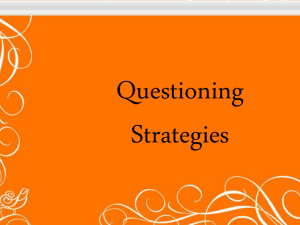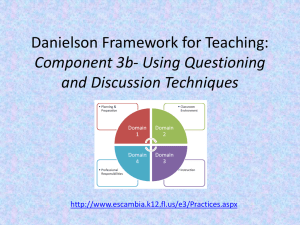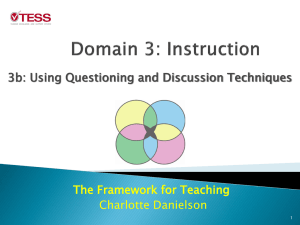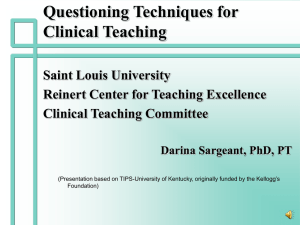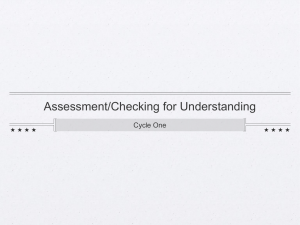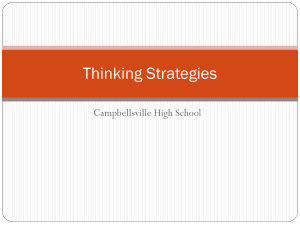Symposium - The Reflective Practitioner
advertisement
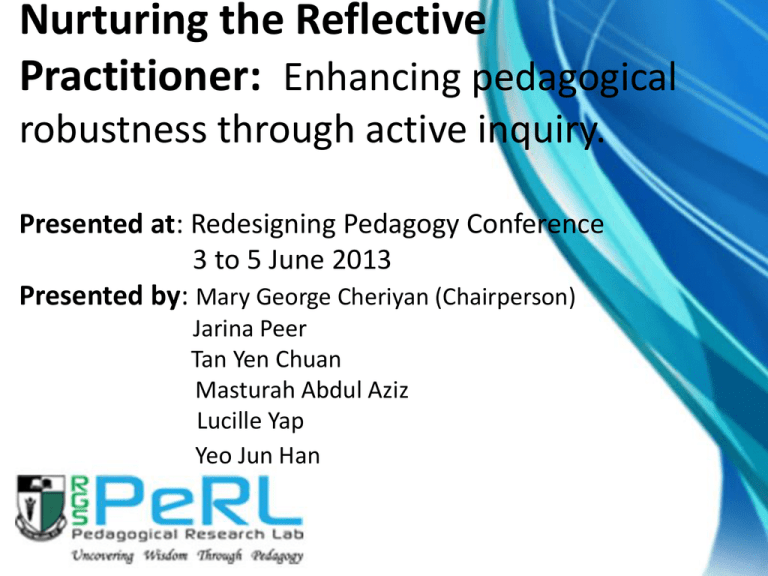
Nurturing the Reflective Practitioner: Enhancing pedagogical robustness through active inquiry. Presented at: Redesigning Pedagogy Conference 3 to 5 June 2013 Presented by: Mary George Cheriyan (Chairperson) Jarina Peer Tan Yen Chuan Masturah Abdul Aziz Lucille Yap Yeo Jun Han The 4 Presentations in the Symposium 1. Enhancing pedagogical robustness through active inquiry. By MARY George Cheriyan 2. The Benefits and Challenges of Practitioner Inquiry: Teachers’ Perspectives By Jarina PEER, Tan YEN CHUAN, MASTURAH Abdul Aziz 3. Effective Questioning, Effective Learning By LUCILLE Yap, Yeo JUN HAN 4. Correlations between Article Review and WatsonGlaser Critical Thinking Appraisal By AZAHAR Bin Mohamed Noor Is good teaching hinged on reflection? Reflective Practice • Reflective practice is the habit of inquiring and investigating a problem situation in order to understand how to frame a solution (Donald Schon,1983) The Moral-Ethical Dimension in Reflective Practice: Attitudes (Dewey, 33) Openmindedness Respect for diversity Humility Hope in the learner Responsibility Considers consequences Makes meaning of experiences for teacher & learner Wholeheartedness/ Engagement Curious about subject and impact of teaching on learning Teaching as an artistry Refines & hones the craft Assertion: Reflective Practice boosts teacher professionalism Calibre Discourse Knowledge Creation • to challenge assumptions of pedagogical practices, be current with estd principles of practice; refine craft • cultivates professional confidencearticulate professional beliefs; learn from others • think & observe critically; frame & challenge theories and models. Assertion: Reflective Practice strengthens theory-practice nexus 3 levels of teacher knowledge and inquiry (CochranSmith & Lytle, 1999) Knowledge of Practice: Teachers generate knowledge by making their classrooms and school sites for inquiry, connecting their work to larger issues, and take a critical perspective on the theory and research of others Knowledge in Practice: Teachers derive practical teaching knowledge from experience, reflection & inquiry Knowledge for Practice: Teachers learn content & pedagogical knowledge from researchers & apply it. PeRL Research Ecosystem How and in what ways can teachers be supported in their development as thoughtful, reflective practitioners, so that they may be active contributors to the teaching community? Schoolwide: driven by Specialists; policy implications Practitioner Inquiry: conducted by indv/ grp of teachers to inquire into a classrm or departmental practice Knowledge Sharing Research Office: -Defines categories -Call for proposals -Protocols -Nomination for -Training PeRL Research Ecosystem Knowledge creation/ sharing Benefits and challenges faced within this ecosystem by teachers who have embarked on Practitioner Inquiry -Integrate with fraternity -Research Build capacity –Assign PeRL Advisors presentations -Publish in Inhouse magazine Protocols submission Oversight Ethics Guidance Platforms Infrastructure & Tools -Software Idea Incubation - Newsletter: trends -align to school’s curriculum review -Website: Resource & Repository Is Good teaching hinged on reflection ? Yes Is Good teaching hinged on systematic inquiry? ie, research design, data gathering and analysis? Possibly: impact on teacher professionalism If the goal is to share it with the larger educational fraternity,… it is necessary. Reflective Practice Systematic Enquiry Metacognition ‘Stepping Stones’ questions Professionalism Participation in educational fraternity Enhance student learning Teacher growth The Motivations, Benefits and Challenges of Practitioner Inquiry: Teachers’ Perspectives Dr. Jarina Peer, Ms. Tan Yen Chuan, Ms. Masturah Aziz Rationale • To develop an understanding of the factors that influence teachers’ readiness in embarking on Practitioner Inquiry (PI) by – investigating the motivations, benefits and challenges faced by them – looking at the support system in place Context • Several teachers in this school have been involved in practitioner inquiry projects; however, there are emerging issues related to this effort to promote PI in the school as – teachers are not researchers and some teachers may not have the necessary research knowledge – experienced teachers often have sufficient tacit knowledge to be able to reflect and improve their pedagogy without research – the ability to do research was not perceived to be a core competency of a teacher Context • RGS PeRL is now looking at lifting the baseline towards encouraging and enabling teachers into a path of a systematic inquiry – Focus is on RGS PeRL facilitated research Research Question • Overarching research question: “What are the factors that influence teacher readiness in embarking on practitioner inquiry?” • Guiding research questions: – What are the motivations, benefits and challenges faced by teachers on embarking on practitioner inquiry? – What are the infrastructure and system in place to support a culture of informed practice? Literature Review The Teacher Growth Model •Due to the multi-faceted nature of teacher’s work, this implies that having a repertoire of strategies and content mastery is not sufficient for a teacher to be a competent professional in the 21 century. st •The teacher will have to pursue professional development through multiple modes of learning, which include reflective practice, researchbased practice, conferences and mentoring etc. (Ministry of Education, 2012) Literature Review Teacher Leadership • Teachers are leaders when they function in professional communities to affect student learning; contribute to school improvement; inspire excellence in practice; and empower stakeholders to participate in educational improvement (Childs-Bowen, Moller, & Scrivner, 2000, p. 28) Literature Review Teacher Motivation •Sylvia & Hutchinson (1985) concluded: “Teacher motivation is based in the freedom to try new ideas, achievement of appropriate responsibility levels, and intrinsic work elements. •They explain that true job satisfaction is derived from the gratification of higher-order needs, “social relations, esteem, and actualization” rather than lower-order needs. Methodology & Data Collection Methods • Methodology: A case study approach To develop a deep understanding on the factors influencing teacher’s readiness in embarking on practitioner inquiry. Data Collection Methods Secondary data: Needs Analysis Survey Document Analysis 3 Focus Groups Discussions 2 Interviews Data Analysis Methods Data Display Data Collection Data Reduction Conclusion: Drawing and Verifying (Miles & Huberman, 1994) Thematic analysis was used to identify recurring patterns in the data • conclusions were drawn and verified through the review and defining of emergent themes • overarching concept and final themes were emerged based on the similarities, differences, patterns and relationship of the data Findings Summary • A shared vision drives a culture of informed practice –the role of PI within the school’s strategic direction –PI is a Viable Solution for: a) b) Theory-Practice Nexus Teacher Professionalism • Teacher’s beliefs and preferences about reflective practice and teacher professionalism motivate their decision –A shared vision shapes the way staff members go about their work and strong leaders play a significant role in building this culture, which, once established, is deeply embedded in the attitudes, beliefs and behaviours of staff members.(Picucci, 2002). Findings Recognition Management Support Shared Vision Regard PI as a contribution comparable to the other established contributions a teacher can make to the school Support Support PI efforts visibly and notably such that it becomes a collective responsibility Value of PI Believe in and advocate in the usefulness of a PI as a Viable Solution Support Structure Investment needed in structures which promote and support PI and productively use findings Infrastructure PI as a Viable Solution Teachers’ Perception Relationships Relationship-building platforms are needed to foster colleagues’ support and participation Improving T&L Improvements in student learning and curriculum are achieved through investigation, evaluation, etc. Professional Development PI affords recognition of work, exposure, opportunities & training for career advancement Personal Interest Passion and interest may lead teachers to pursue PI for their own personal satisfaction Findings Final Themes Supporting Evidences Management Support “There must be more extrinsic motivation, in terms of giving them [teachers] time and recognition of what they do.” - Recognition - Support - Value of PI “Although there are encouragement for teachers to do PI, but it is more of teachers’ own initiative …” “The higher management sees the usefulness and support you in doing the PI.” Infrastructure - Support Structure - Relationships “You need to set up a kind of task force, start up a committee, identify someone who is able to spearhead, e.g. someone who is trained in doing research, but also at the same time getting people in the department to work together to gather data from many classes. The support.” “When you work as a team, you need to work with people who are able to do it and want to do it.” Teachers’ Perception of PI “Embark on PI to find an answer to solve a concern about something/ a problem.” - Improving T&L - Professional Development - Personal Interest “The topics that I choose to do action research will be those that can show improvement in students’ standards and command of language/ writing.” “Have the opportunity to collaborate with external researchers/ teachers/ colleagues with common interest/ common discipline.” “Action research has always been something that I wanted to do.” Findings Challenges to Teachers’ Readiness in embarking on PI •Challenges surfaced allow identification of strengths and Areas for Improvement (AFIs), and will be elaborated further in the next section. •Challenges identified from data are: –More tangible value attributed to PI is needed –Recognition of teachers’ contributions in terms of teaching and learning and professional development –Fine-tuning existing structures –The resistance to change when findings are proposed to be implemented on a bigger scale –Viable Alternative Solutions which may seem more attractive than PI –Lack of interest in conducting research –Enhancing teacher competencies and confidence Discussion & Recommendation A Shared Vision to Promote a Culture of PI Strength • RGS promotes a culture of PI, thus, an infrastructure has been set up in the form of RGS PeRL. Areas of Improvement • This Shared Vision has to be instilled across all levels, through 1) Management articulation of PI as a strategic focus 2) Improved Infrastructural Support Discussion & Recommendation 1) Management Support Strengths •Based on the document analysis • RGS supports PI as a viable solution to strengthen the theory-practice nexus and enhance teacher professionalism. • RGS PeRL provides support and structures to drive PI as a school-wide approach AFIs •To embed PI in the school culture, the school management will need to incorporate PI within the school’s strategic direction Discussion & Recommendation 1) Management Support Recommendation • PI needs to be recognized as a valid contribution to the school by ⁻ • Attributing it as equivalent to that of a departmental duty Including it in work review discussions Discussion & Recommendation 1) Management Support • Based on the Needs Analysis: 15% would like to consult their superiors before embarking on PI “Today’s teachers don't necessarily look for answers from an instructional leader. But they need to know that their leader understands and appreciates their work and recognizes their challenges and frustrations” (Hoerr, 2008, p. 2) Discussion & Recommendations 1) Management Support Recommendations • Key personnel should lead by example. • The Heads need to consciously and decisively apply PI findings to curriculum improvement, e.g. ⁻ ⁻ Review pedagogical approaches Utilize proposed solutions to Areas For Improvement (AFIs) in their own departments Effective school leadership today must combine the traditional school leadership duties and include a deep involvement with specific aspects of teaching and learning and effective instructional leaders are intensely involved in curricular and instructional issues that directly affect student achievement (Cotton, 2003). Discussion 2) Infrastructure (Work Structure and Support Structure) What Works • RGS PeRL’s infrastructure for PI provides critical oversight: ⁻ ⁻ ⁻ ⁻ Protocol: Call for Proposals, Documentation & Statement of Ethics Training via in-house and external workshops Mentorship Dissemination • RGS PeRL’s integration with school’s curriculum • Theory practice nexus/indigenized research • Teacher professionalism Discussion & Recommendations 2) Infrastructure (Work Structure and Support Structure) AFIs • Meeting teachers’ higher aspirations to apply their research beyond their own practice. • Enhancing PI rigor and standards • Addressing teachers sense of readiness: 61% of the all the teachers who completed the needs survey indicated that they would like to develop their research skills Recommendation • PeRL needs to evaluate and respond to the evolution of reflective practice in the school • PeRL advisors act as a bridge between teachers embarking on PI and Heads Discussion 3) Teachers’ Perception of PI A. Value of PI •Improving teaching and learning •Professional Development –Recognition –Exposure & Opportunities –Networking and Collaboration –Acquisition of skills and competencies Discussion 3) Teachers’ Perceptions of PI B. Personal Interest • An inherent motivation to conduct PI is due to –an interest or aptitude in conducting research –the desire to try new things and venture into new frontiers –a passion in their niche areas of pedagogy –an interest in a field such as ICT which integrates well with pedagogy Conclusion • It is hoped that insights from the study will inform the school on how to – – • Enhance teacher professionalism Strengthen the theory-practice nexus which drives the school culture of informed practice Ultimately, such initiatives may boost teacher readiness in embarking on PI, and in the long run, contribute to the development of a robust professional learning community. Further Studies • Culture of PI in the school should be re-visited to track improvements Implementation of some of the recommendations outlined may assist in the formation of a Professional Learning Community (PLC) • • a study conducted in the near future may then shed some important findings on the feasibility, viability and sustainability for the school to construct a PLC from a bottom up approach, instead of top down approach Limitations • The participants varied in their involvement of PI, hence there may be a lack of in-depth descriptions about some aspects of the topic discussed. • Due to time constraints, member checks were not conducted where participants could provide feedback to check the accuracy of their interview transcripts. References Ali Callicoatte Picucci, A. B., Rahel Kahlert, & Andy Sobel. (2002). Shaping school culture. Principal Leadership, 3841. Ary, D., Jacobs, L. C., Razavieh, A., & Sorensen, C. (2006). Introduction to Research in Education: Wadsworth Publishing. Auerbach, C. F., & Silverstein, L. B. (2003). Qualitative data: an introduction to coding and analysis: NEW YORK University Press. Bromley, D. B. (1986). The case-study method in psychology and related disciplines: Wiley. Cochran-Smith, M., & Lytle, S. L. (1993). Inside/Outside: Teacher Research and Knowledge: Teachers College Press. Cotton, K. (2003). Principals and student achievement [electronic resource]: what the research says: Association for Supervision and Curriculum Development. Dana, N. F., Gimbert, B., & Silva, D.Y. (1999). Teacher inquiry: Staff development for the 21st century. Pennslvania Educational Leadership, 18(2), 6-12. Dewey, J. (1933). Democracy and education. New York: Free Company. Hatch, J. A. (2002). Doing qualitative research in education settings: State University of New York Press. References Hoerr, T. R. (2007). The Principal Connection/ What is Instructional Leadership? Informative Assessment, 65(4), 84-85. Hubbard, R. S., Shagoury, R., & Power, B. M. (2003). The Art of Classroom Inquiry: A Handbook for TeacherResearchers: Heinemann. Miles, M. B., & Huberman, A. M. (1994). Qualitative Data Analysis: An Expanded Sourcebook: SAGE Publications. PeRL, R. (2012). RGS PeRL Handbook 2012. Singapore: Raflles Girls' School Pedagogical Research Lab. Punch, K. F. (1998). Introduction to Social Research: SAGE Publications. Rubin, H. J., & Rubin, I. S. (2005). Qualitative interviewing: the art of hearing data: Sage Publications. Sylvia, R. D., and T. Hutchinson. (1985). What makes Ms. Johnson teach? A study of teacher motivation. Human Relations(38), 841- 856. Yin, R. K. (2009). Case Study Research: Design and Methods: SAGE Publications. RGS PeRL Team Involved • • • • Mrs. Mary Cheriyan – Director, RGS PeRL Dr Jarina Peer, Head, Research Ms. Tan Yen Chuan, Teacher-Specialist Ms. Masturah Abdul Aziz, Research Executive We Would Like to Thank • Tan Ean Kiam Foundation • Staff of RGS who were involved in the study by Mrs Lucille Yap-Chua Puay Lan Mr Yeo Jun Han RESEARCH QUESTION How can a positive questioning attitude enhance student learning? CONTEXT ‘….. questions asked during a lesson are those initiated by the teacher and only rarely by the students, and that questions do not emerge spontaneously from students; rather, they have to be encouraged. In cases in which students do ask questions during lessons, they are usually informative ones.’ (Dillion, 1988) CONTEXT ‘The content of a question can indicate the level of thinking of the person who raised it. In general, the cognitive level of a certain question is determined by the type of answer it requires.’ (Yarden, Brill, and Falk, 2001) Purposeful inquiry does not happen spontaneously. It must be learned. (Baird, 1990, p 184) AREA OF STUDY FOCUS * 1 Year 3 class & 3 Year 4 classes This study focuses on the ability of upper secondary Geography students*, who learn Geography through the inquiry approach, to ask meaningful and geographically relevant questions. INTENT • Foster a positive questioning attitude in high-ability girls; to seek information for its own sake as much as for its usefulness. • Develop the students’ ability to ask more and better questions resulting from an inquiry-based instruction. INTENT • Create a safe and non-threatening environment in which students are given opportunities to pose questions. • Establish and maintain communication with students. METHODOLOGY Identify Research Question Present Findings Inform students of intended Action Research STEPS Present findings and make recommendations IN ACTION Collate and RESEARCH interpret data Design and conduct postQuestionnaire Design and conduct preQuestionnaire Infuse questioning tools into classroom instruction INTERVENTIONS : Questioning Techniques INTERVENTIONS : Questioning Techniques INTERVENTIONS : Questioning Techniques PRE- and POST- QUESTIONNAIRE FINDINGS: Characteristics of Effective Questioning I. WAIT Time One has to wait after asking a question before answering it oneself or going on to ask further questions or making further points. Questions Pre-Test Post-Test 1. 72.5% 96.7% 2. I use WAIT time to think about answers. 72.5% 92.7% 3. I give WAIT time to my classmates when asking questions. 52.5% 84.6% The teacher gives me WAIT time before I answer his/her questions. Waiting is a sign that you want thoughtful participation. (Wang, 2003) DISCUSSION: Characteristics of Effective Questioning I. WAIT Time • The provision of WAIT time allows for metacognition, and an increase in frequency and length of student responses (including unsolicited responses). • WAIT time has to be applied judiciously: the optimal wait time for a given question depends on the cognitive level of the question and student expectations. FINDINGS: Characteristics of Effective Questioning II. Higher-order Thinking, HoT (Critical & Creative) Higher-order thinking is more than the learning of facts and concepts. It requires more cognitive processes and it involves the learning of complex judgmental skills such as decision making and problem solving. Questions Pre-Test Post-Test 1. I ask questions to justify a decision or an outcome. 67.5% 93.5% 2. I ask questions to examine multiple viewpoints or perspectives. 61.7% 92.7% 3. I ask questions that allow me to apply 62.5% knowledge or a procedure to a familiar or unfamiliar task. 92.7% Dead questions reflect dead minds. (Paul, 2000 ) DISCUSSION: Characteristics of Effective Questioning II. Higher-order Thinking • Higher level order of questioning from Bloom’s taxonomy, like questions that require analysis, synthesis, and evaluation, can trigger a higher level of thinking. • Questions drive thinking; high-order questions drive our thought beneath the surface of things and force us to deal with ambiguity and complexity. No questions equals no understanding, and thereby, no learning. • Higher-order thinking skills, though difficult to teach and learn, can be developed as such skills are valuable: they are more likely to be applied and usable in real-world situations. FINDINGS: Student Metacognition Metacognition Knowledge and control of one’s thought and learning processes; being able to know how to learn, to monitor one’s own understanding, to reflect about one’s understanding, and to strategize about how to resolve one’s confusions. Questions Pre-Test Post-Test 1. I think and formulate responses to questions asked in class. 67.5% 93.5% 2. I answer questions at the appropriate cognitive level. 65.0% 89.4% 3. I can explain the thinking that led to my answers in class. 74.2% 93.5% To make an individual metacognitively aware is to ensure that the individual has learned how to learn." (Garner, 1988) DISCUSSION: Student Metacognition Metacognition The questioning attitude could increase metacognition, or an awareness of thinking, in students. Metacognition calls for elaboration and application of one’s learning which can result in enhanced understanding. In brief, time for reflection in order to engage oneself in monitoringplanning-evaluation would inspire learners’ engagement with higher order thinking and reasoning. FINDINGS: Student Attitudes and Perceptions Attitudes and Perceptions Student attitudes and perceptions affect the learners’ mental climate of the classroom. If students have positive attitudes and perceptions, they have a mental climate conducive to learning; a sense of acceptance and a sense of comfort and order. Questions Pre-Test Post-Test 1. I am comfortable asking questions in class. 56.6% 82.9% 2. I am confident in asking questions in class. 56.6% 73.2% I ask a mix of different types of questions at all 38.3% cognitive levels: knowledge, comprehension, application, analysis, evaluation and synthesis. 75.6% 3. Attitudes and perceptions affect the classroom climate. (Marzano, 1992) DISCUSSION: Student Attitudes and Perceptions Attitudes and Perceptions Student attitudes and perceptions drive motivation and behaviour. When students are convinced of the value of questioning, they would i. cultivate a positive questioning attitude, ii. develop their questioning skills to seek clarifications and to broaden and deepen their body of knowledge and iii. have a mental climate conducive to learning . Achieve academic success Teachers need to continually foster and reinforce positive attitudes and perceptions about the learning climate and model the way. OTHER FINDINGS: Outcomes 97.6% - Questioning is a skill that can be developed. 82.1% - My questioning skills have improved. 95.1% - My capacity as a learner has increased through questioning. 65.8% - I have developed the art of questioning. 86.2% - My academic performance has improved through questioning. 94.3% - I have developed a critical mind through questioning. Questioning Thinking Learning STUDENT VOICES (Shirley Wang, class 412, 2012) STUDENT VOICES heavy and time-consuming.” (Justina, class 301, 2012) CONCLUSION • As classroom practitioners, we know that effective questioning is critical to student learning and student academic success. Therefore, the need to develop a questioning mind in our students is essential. • The inquiry-driven approach to teaching and learning requires constant practice and reinforcement if inquiry is to be integrated into classroom instructional practices. • Higher-order thinking skills, including metacognitive awareness and metacognitive development, are complex and require a supportive (positive and affective) environment. • An effective learning environment in which students are given ample opportunities and time to develop their questioning skills would develop the students’ ability to ask more and better questions about phenomenon around them. CLOSING REMARK “What’s in a question, you ask? Everything. It is a way of evoking stimulating response or stultifying inquiry. It is, in essence, the very core of teaching.” (John Dewey, 1933) REFERENCES • Wang,C.M. and Ong, Grace (2003), Questioning Techniques for Active Learning, in Ideas on Teaching, Volume 1, Centre for Development of Teaching and Learning (CDTL), National University of Singapore. • Walsh, J.A. & Sattes, B.D. (2005), Quality Questioning: Research-based Practice to Engage Every Learner, Corwin Press, Australia. • Marzano, R.J. (1992), A Different Kind of Classroom : Teaching with Dimensions of Learning, Association for Supervision and Curriculum Development,ASCD, Alexandria,VA. Nurturing the Reflective Practitioner Correlations between Article Review and Watson-Glaser Critical Thinking Appraisal Azahar M Noor Nurturing the Reflective Practitioner Correlations between Article Review and Watson-Glaser Critical Thinking Appraisal 5 June 2013 Azahar M Noor Critical Thinking • MOE’s “Desired Outcomes of Education” states that: by the end of post-secondary education, students should be able to think critically. • Integrated Curriculum Model (ICM) as used in Raffles Programme proposed that curriculum for the gifted should be differentiated and organised around high level thinking skills. Research Questions 1. What is critical thinking? 2. Is there a correlation between students’ performance in the Watson-Glaser Critical Thinking Appraisal (WGCTA) and their performance in the Article Review (AR)? Hypothesis: Since both are tools to measure critical thinking, there should be a correlation between students’ performance in both tests. Some Definitions of CT • VanTassel-Baska (2006) included four process elements: to judge or evaluate, comparing and contrasting ideas, to generalise from concrete to the abstract, and to synthesise information within or across disciplines. • Yeap, L.L. (2004) observed that critical thinking determines the credibility of certain facts and sources, detects biasness, evaluates the soundness of arguments and distinguishes the relevant from the irrelevant. • Paul, R. (2007) defined critical thinking as thinking that analyses thought, that assesses thought, and that transforms thought for the better. • Lipman, M. (1991) defined critical thinking as thinking that facilitates judgement, because it relies on criteria, is self-correcting, and is sensitive to context. Defining Critical Thinking • Teachers may lack clarity as to what CT really means. • Defining CT may be complex due to: - variety of definitions and, - it involved multitude of skills eg Paul, R (1990) identified 9 micro skills and 16 macro abilities related to critical thinking. Before we seek to measure and develop CT, there needs to be clarity and consistency in defining CT. Hence, identifying the core characteristics of Critical Thinking can serve as a guide and working definition for teachers. 1. Critical Thinking involves High Order Cognitive Skills 3 Core Elements 1: CT involves evaluating the validity and falsity of an assertion. Some definitions use the term “argument” instead of “assertion”. 2: CT involves making a judgement that relies on criteria. Some definitions may emphasise “making generalisations” instead of “making a judgement”. 3: CT involves metacognitive self-evaluation. Some definitions use the term “self-correcting”. 2. Critical Thinking involves Disposition to think critically Role of affective dispositions • Halpern, D. F. (1998) ..the thinker must be willing to put in the required mental effort as he may choose not to engage in critical thinking even if he has excellent critical thinking skills. • Paul, R. (1990): identified nine traits of critical thinking, in which he emphasised the intellectual and moral commitments necessary for a person to improve the quality of his thinking. • Implication to Teachers ? Is there a correlation between students’ performance in the WGCTA and their performance in the AR? Why is this question important? •AR as a Proprietary Instrument •Validation: concurrent validity test What is Article Review? An assessment tool used in RP for Social Studies curriculum in Yr 3 and 4. • Seen and Unseen Article – differing viewpoints on an issue. • On assessment day, students must bring the Seen Article into the exam room with their annotations. The Five Critical Thinking Domains Tested in WGCTA • Inference: Students are required to draw conclusions from certain observed or supposed facts. • Recognition of Assumption: In this test, students are required to decide for each given statement, whether an assumption is made, or not made, by the person. • Deduction: Students are required to judge whether a conclusion necessarily follows from a statement. • Interpretation: Students are required to read a short paragraph and decide, for each of the given conclusion, whether the conclusion logically follows, or does not follow. • Evaluation of Argument: Students are given a series of questions. Each question is followed by several arguments. Students are required to decide if an argument is strong or weak. For an argument to be strong, it must be both important and directly related to the question. WGCTA’s 5 Domains AR CT Skills •Inference •Recognition of Assumption •An impt skill for AR. •Deduction: •Interpretation: •Evaluation of Argument: •Skill is part of close reading but not assessed •Students required to identify & qn assumptions. Overlap but more difficult in AR. In WGCTA, student just makes a “yes” / “no” choice. •Skill is part of close reading but not assessed •Evaluation of article is assessed eg has the author presented a convincing argument … ? Skills in AR which are NOT tested in WGCTA • Comparative analysis: The 2 contrasting articles will demand skills in comparison. • Making a judgement: Students are required to make a judgement on an issue, based on the contrasting views presented in the 2 articles given. In making a judgement, students have to develop their own criteria, consider contextual realities and present their views on the issue given. Comparative analysis and making a judgement put AR at a higher level of sophistication in terms of CT skills Methodology • • • • 96 Year 4 students selected. Stratified sampling (interval of 5 names) Data: AR End of Year Assessment scores WGCTA test scores conducted in Term 4 SPSS was used to run correlations test AR Test against WGCTA N All students 96 Top Performers (60% of students who scored 4.0 in AR) 56 Average Performers (Bottom half who scored < 4.0 in AR) 40 AR Mean score 78.8% Highest: 100% Lowest: 53% 88.5% 70.2% WGCTA Mean score 82.6% 83.0% 82.1% • The mean score for the total WGCTA was 82.63%. This · The mean score for the total WGCTA was 82.63%. This placed the 96 students at placed the 96 students at 93.43 percentile based on Grade 93.43 percentile based on Grade 11 norms - showed a high level of CT skills. 11· normsthis showed a high level of between CT skills There was a marked difference (dispersion) the mean scores of top and • There was performers a marked between the mean scores of average in difference the AR · and Thereaverage was little difference in thein WGCTA mean scores between average and top top performers the AR. • Littleperformers difference in WGCTA scores (Top vs Aveg) Is there a Correlation? Terms • Correlation measures the relationship between 2 variables (+ or -). Correlation does not equal causation. • Statistically significant = the result does not happen by chance. Significance level was set at 0.05. • If result = > 0.05, means it is not statistically significant • If result is < 0.05, means only less than 5% that the result happen by chance. Result is thus statistically significant. Results of correlations test • The correlation between the TOTAL WGCTA scores and AR scores was not significant. • Results for 4 domains of “Recognition of Assumptions”, “Deduction”, “Interpretation” and “Evaluation of Arguments”were also not significant. • Only “Inference” scores were statistically significant, but the strength of correlation between “Inference” and AR scores was weak. • Results were not expected : ( Conclusion •Different format: WGCTA used multiple-choice format while AR is essay writing. Hence language could be a major influence in the results eg a student may have high CT skills, but may not be able to express their ideas clearly. Teachers may grade the essays for clarity of expression. •The other skills tested in the AR have substantial influence on students’ performance. These are not captured in WGCTA esp comparing and contrasting skills •If a student is able to prepare for AR, the need to apply CT is diminished. Implications • Perhaps expand the 3 criteria rubric to four to sharpen assessment on CT skills that the AR seeks to develop and assess. • Review implementation, reduce spotting and pre-prepared answers. • WGCTA showed the students have high CT. How do we translate high CT to high performance in the AR? Makes CT more salient in class. • Not able to validate AR yet. Follow-up • Sharing within Humanities Department. • Social Studies team decided on: 1.Rubric was revised to 4 criteria effective 2012 2.The team reflected on how we can teach CT more explicitly. 3.WGCTA shows lower scores in Inference skills which we deemed as “more basic” and “easier”. Introduced Argument Mapping in 2013 as build inference skills and accuracy in reading an integral skill to CT. Interestingly ………When WGCTA scores were compared with overall SS grades • Correlation between total WGCTA scores and SS grades was highly significant --> CT skills have an influence on students’ SS performance (AR, PT and CBA). • “Inference” and “Evaluation” domains are also statistically significant (but not the other 3 domains), although the strength of the correlations is weak. Thank You CONTACT INFORMATION Pedagogical Research Lab Raffles Girls’ School (Secondary) 20 Anderson Road Singapore 259978 DID: (+65) 68387851 Fax: (+65) 62353731 Web: www.rgsperl.edu.sg Email: rgs.perl@rgs.edu.sg
